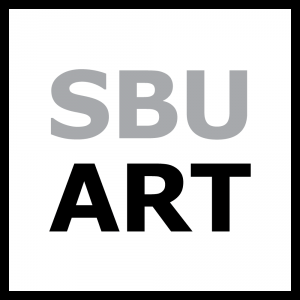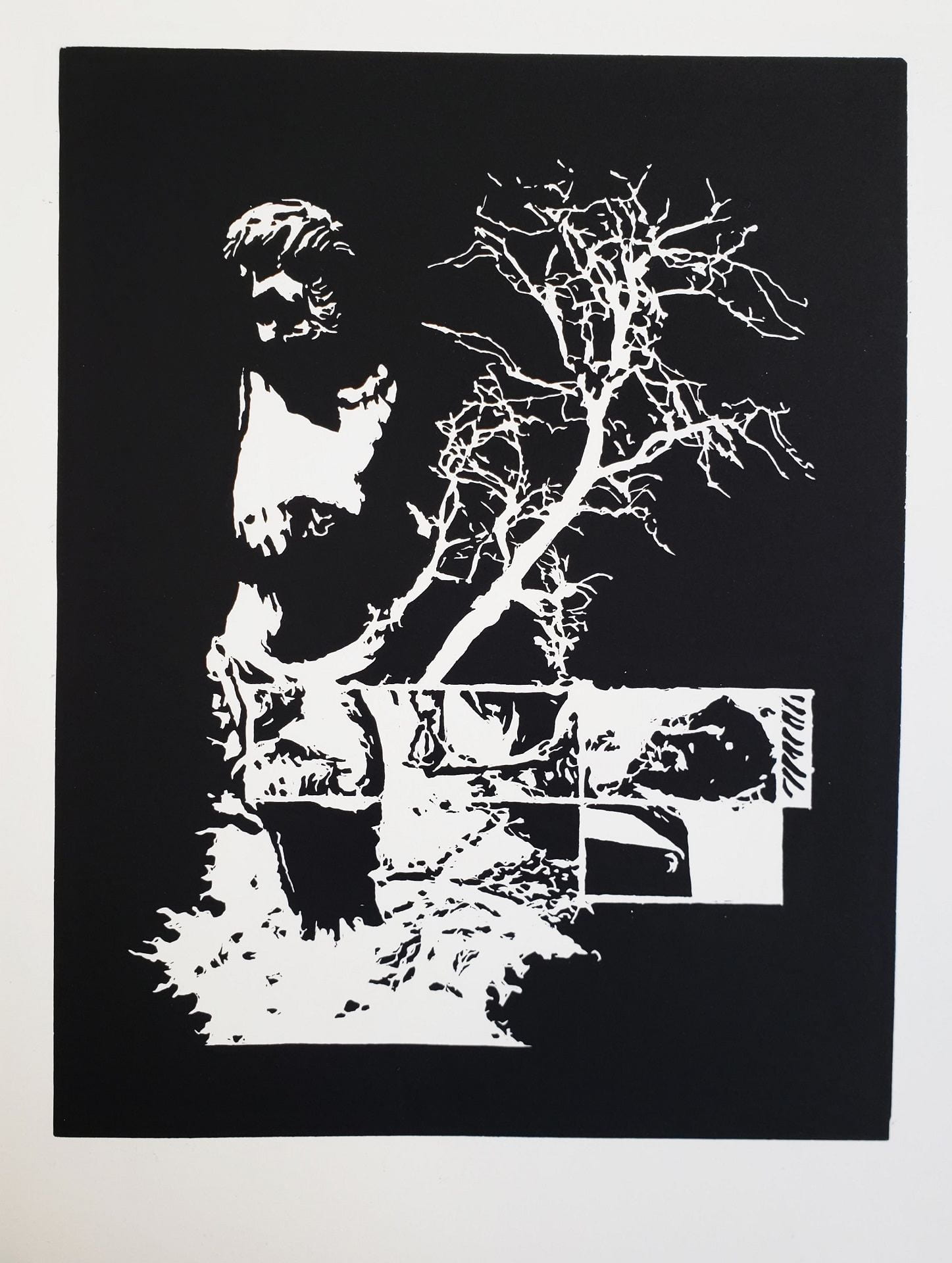-
Jason Jenkins
Doctrine of the Body: The Crucifixion, The Descent Into Hell, The Ascension
2020
LinoleumSacred experience through the Crucifixion and collage.
He was crucified, dead and buried – he descended into hell. On the third day he rose again – he ascended into heaven.
This line was truly impressed in me as a child, and I supremely remember being struck with the radicality of the descending into hell. This was also something I learned wasn’t universally taught. Later in my life, somewhere from age 16-18 I remember the apocalyptic moment that revealed to me in a mystical experience a new perspective of crucifixion. At that time, it did not just mean the crucifixion of Christ, this meant crucifixion as the ultimate form of punishment, and that of sacrifice used worldwide. The extremeness of this shocked me to the point of an ineffability that would in ways be a guiding light on the path of my academic interest.
Again, this was always pressed with the radicality of the bodily – the experience.
The Crucifixion, shows the unification of God and man. Understood with the aid of Neville Goddard’s lecture A Mystical Experience, God empties into man and dies as man (the created), so that man may rise as God (the creator). Furthermore, Georges Bataille explains in On Nietzsche that this sacrifice, which was intended by God and acted by man, creates a wound (one’s lacerated integrity/ boundaries) through which communication with the creator is possible.
Communication is love, love is unification.
The Descent Into Hell, divinitizes all flesh – at all and every level. Thinking of what J.K. Huysmans called vulgar faith while discussing the works of Northern Renaissance artist such as Grunewald, and understanding how images of divine and sacred subjects in seemingly vulgar forms would set them at a level on which anyone, for example someone suffering from a disease such as St. Anthony’s fire, could see a blistered, lacerated and corpse Christ hanging from the cross and thus be carried visually through healing (or at the very least a good death) to the image of his resurrection. Further, this descent into hell is the part that makes it permanent. The death on the cross – it can’t be reversed. At once, this speaks to possibilities and calls forth rebirth. We can even consider this point a total incarnation of being – the possibility of full redemption that comes with total negation or the self-annihilation of God that “reveals the totality of our darkness (Altizer, New Gospel, 100). Most importantly Thomas J. J. Altizer explains that the union which occurs between the Creator and Satan in hell, sees the Redeemer (God as man redeeming God) finally in a “dialectical union with his very opposite (101).” This principle mixes what’s perceived as opposites.
The Ascension. About six years ago I was told that God is within you – this meaning everyone, but I never bothered to verify it in writing in case I ran into some contradictory information or found that it was true. I spent the first half of this year studying the realm around Surrealism, philosophy and some psychoanalysis. I found myself – and still do – referring to the work of four writers whose influence in my life is truly mystical. They are, Georges Bataille, William James, Sabina Spielrein and Roger Caillois. Most recently I would add Thomas Altizer to this list because of how he radicalized the death of God in a language that impaled me with curiosity. These views of experience, change – creation, death and incarnation have been measures to guide me and limits to shatter or structure at my will. This brings me to the last image dealing with the internalization of the sacred (Caillois, Man and the Sacred, 132). From his book Man and the Sacred, I found this as something Roger Caillois sees happening when the sacred is no longer restricted to the world of religion. The sacred, and how it’s encountered becomes dramatically personal and individually specific – the sacred can be accessed through anything at full strength no matter how fragmented it seems from the so-called original source. An example of this is that a relic of a saint still has the full power of a saint (Caillois). One day this year I finally decided to search for where in the Bible or some sacred text would reflect what I learn – I found it in Luke 17:21, which says the king of heaven is within you. This made me curious enough to pair like words and see what happens, so I thought of this in context with on the third day he rose again – he ascended into heaven. This reflected in some way everything of what I’ve learned; the internalization of the sacred, the laceration and death through which union and life is possible, the permanence of sacrifice – the creator empties himself into the created to become the created, which in rising from the dead, rather given new life, realizes himself unified and as the creator with the power to create.
Every image begins with fascination, or as Bataille would explain – eroticism.
All the imagery I chose sparked an infectious sense of fascination in me which propelled me into a summit, further annihilating any boarders between the source materials and myself. It’s a process of communication and automatism. In some ways it becomes mechanical. After the first composition I render each image from its original color and transfigure all tones pure black and white. This is where the process takes over itself through the mechanical software.
Before rendering I create a white frame designating my workspace and container, rather, the temple space prepared for the sacred. Following that I invoke each image one by one. Rendering them lacerates their integrity to allow conversation and stabilize the raw sacred energy. This is a mirror of incarnation as well as negation as its export. The image is rendered three more times, none of which the outcome is concretely determined, as it goes from transferring the image to the block, to carving and printing – each print contains the entirety of the initial fascination.
That fascination is carried through creation and creating. Every object that sparks inspiration, was created from inspiration – everything carries with it the trace of its creator. Collage, which is the process I use to join together images that once may have been perceived as separate is a clear example of this internalization and transfer. Not only that, but its creation reflects the markers of a mystical experience presented by William James in Varieties of Religious Experiences, and explained as ineffability, noetic quality, transiency, and passivity (James, Varieties, 281).
The myth, process and experience are incredibly personal, yet because it does bear witness to inherit truths and is left open (lacerated) – vulgar – filthy from process it stands as a fully functional fetish item capable of communication and carrying a fragment of the sacred open to interpretation and rendering.

Department of Art | Stony Brook University | 2224 Staller Center for the Arts | Stony Brook, NY 11794-5400
631.632.7250



